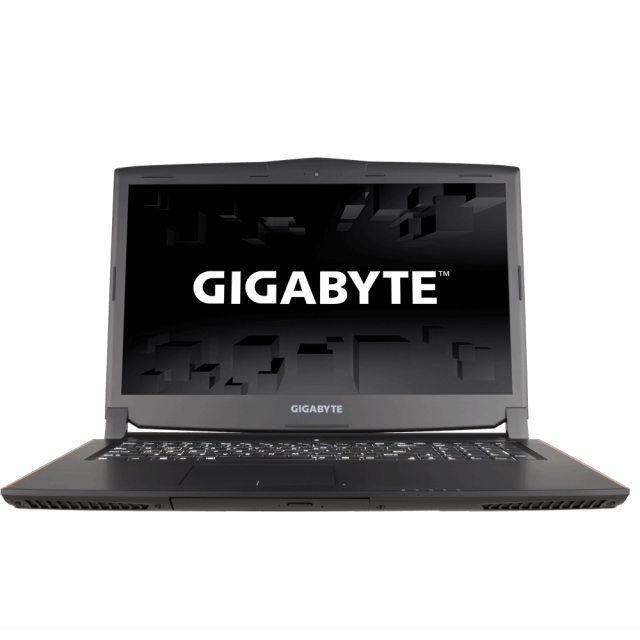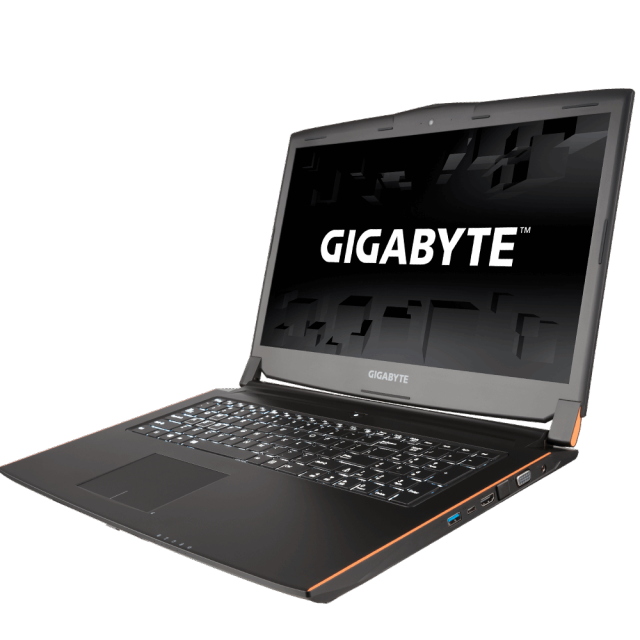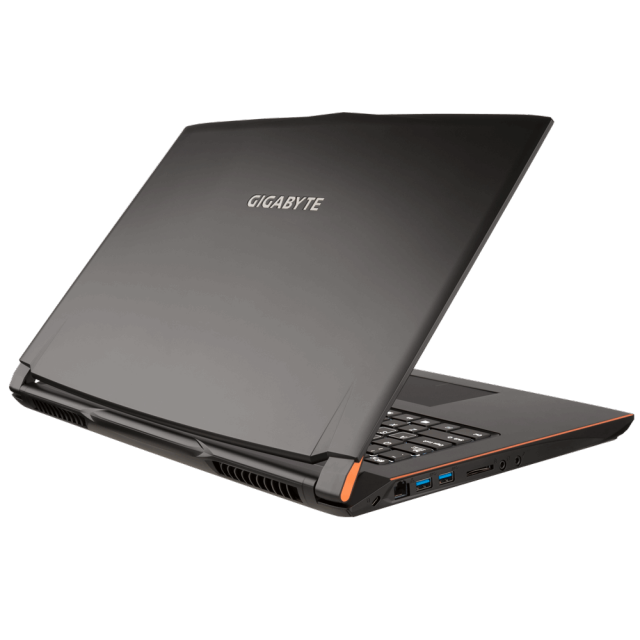
Gigabyte P57 v6 Laptop Review
I must admit I’ve never been one for gaming laptops. I know they’re for those who want powerful gaming on the go or a capable space saving machine for home, but for me, I’ve never truly seen them as a desktop replacement, even though many manufacturers try and make theirs out to be. The real problem had always been performance, they’ve always taken a hit with gaming laptops as they use a mobile version of their desktop brothers. This being solely due to mobile versions of performance chips, CPU and GPU being designed to a maintain lower power consumption and reduce heat.
This is no longer the case as Nvidia has just changed the game. With the arrival of Nvidia’s Pascal chipset and the release of the 10XX series of graphics cards, Nvidia has gone and ditched the mobile range and stuck full desktop versions of their GTX 1060, 1070 and 1080 cards inside the newest gaming laptops. It’s an impressive feat and closes the performance gap between desktop GPU’s. But in real world gaming, how do they really compare? To find out, I was kindly sent the Gigabyte P57X v6, with the latest i7 mobile chip, and an 8GB GTX 1070 to review and benchmark beside my own 1070.
Before jumping straight into the benchmarks and the performance of the P57X v6, let’s talk about the laptop itself as it is a beastly machine. Upon unboxing I was greeted by a massive matte black slab of plastic with a rather fetching orange trim across the sides. It didn’t look unpleasant and besides being made entirely from plastic; it felt very sturdy, balanced and wasn’t too bulky. It also had a good weight to it as well. Weighing in at around 3.0kg, it’s not the lightest by all means, but considering the size and power underneath it was acceptable. Still, I wouldn’t have it sat on my lap for any long periods of time as looking underneath shows two large vents either side as well as another set on the back of the unit to ensure maximum cooling and ventilation.
Lifting the lid reveals the Full HD (1920x1080), IPS 17.3” screen, the largest screen available from Gigabyte’s laptop range, and another set of two vents which I mistook for speakers, located on the front. Fans of full-sized keyboards will be happy here, as the P57X v6 also includes a fully backlit keyboard with num pad, your standard multi-touch trackpad, and a power button centered above the keyboard.
When it comes to ports and connections, the P57X v6 has no issue here. Featured along the sides of the laptop is a power connection for the included 200W PSU, a VGA port, a HDMI 2.0 port (supporting 4K 60Hz), a MiniDP, a USB Type-C port and a USB 3.0 port on the left side and on the right: a RJ45 port, another two USB 3.0’s, SD card reader and your headphone and microphone ins. The front of the unit also includes Blu-ray/DVD-RW drive, rather unnecessary these days in my opinion, but fortunately, you’re provided a swappable HDD bay, so you can ditch the disc drive for an additional 2.5 hard drive.
Under the hood, besides the impressive 8GB GTX 1070, we have an Intel i7-6700HQ - a 6th gen Skylake chipset that’s popular among many high-end gaming laptops - and 16GB of DDR4 memory (2133Mhz).

Now, the real fun begins the gaming performance and testing. As I said at the start, my curiosity with the laptop lied within the performance of the GTX 1070 and how it compared to my own desktop version. For this, I have tested a number of games and hook the laptop up to my UHDTV for some 4K gaming.
The games tested were: Battlefield 1, Grand Theft Auto V and Rainbow Six Siege. GTAV and Siege both offered benchmark tools within the game, but Battlefield 1 does not so I calculated an average FPS from playing the campaign and the multiplayer for about half an hour. I repeated the process hooked up to my TV using the 4K resolution (3840x2160) to really push the system. Outside of gaming, I ran benchmarks on Unigine’s Heaven and Valley. And to finish off I ran a 3DMark Firestrike test on normal and at 4K.
Starting with Battlefield 1, I played out the opening campaign level on Ultra, 1080p and I averaged a nice 90 fps, with highs of 100 and a low of 70 - which occurred during a massive explosion. It was perfectly stable throughout and the GPU inside bested the 1080p resolution with ease, so there was certainly of headroom to push the performance further. I decided to crank up the resolution scale within to 133%, this made the resolution output equal to 2560x1440. After this, we now saw an average of 77 fps - again, still quite impressive. I then tested 4K and this is where things took a hit. Still using Ultra settings the average dropped down to 43 fps - still playable, but far from perfect. After some adjustments to graphics, resulting in settings with a mixture of Ultra, High, Medium and Low I was able to hit that stable 60FPS sweet spot with an average of 64 fps. This being solely campaign, it’s more tightly scripted than the multiplayer and that’s where things differ slightly.
Using Ultra settings, 1080p I played two, 64 player Conquest rounds on St. Quentin Scar, which features trenches, open fields, and a destructible village and Amiens a city-sized map with plenty of destructible buildings and close-quarter combat. Both ran perfectly smooth at 1080p. St. Quentin Scar averaged 85 fps and Amiens 80 fps. Cranking up to 1440p dropped things down about 10 fps leading to 74 fps on St. Quentin Scar and 68 fps on Amiens. I didn’t test 4K resolution on multiplayer but going by the campaign, it would yield similar results.
Overall, the results within Battlefield 1 proves that the GTX 1070 is more than capable of handling itself, especially at higher resolutions. Moreso, the performance was very close to the performance of my system, I tested at 2560x1440 and while mine gained around 10 fps higher most of the time, I believe this is down to my CPU advantage - mine being an i7 3770K @ 4.5ghz compared to the boosted clock of 3.5ghz on the P57X - this would be something I’d notice throughout.

Next tested was Grand Theft Auto V and Rainbow Six Siege. In both titles, I ran there in game benchmarks at the highest settings at 1080p and 4K. I was unable to test 1440p, as I encountered a problem, going through all the available resolutions hooked up to the TV, 2560x1440 was not available. I even went and created a custom resolution with the Nvidia control panel and it wouldn’t display, so I can only assume this is a limitation of the GPU’s output via HDMI, as I didn’t have this problem on my PC. I also noticed that Nvidia’s great Fast Sync technology, which allows for an uncapped framerate without screen tearing, was also unavailable. But besides this, I still went ahead and ran the benchmarks.
Grand Theft Auto V and at 1080p, with everything set to Very High and Max View Distance produced an average of 70 fps with a high of 124 fps. Then, keeping with the same settings and reducing the view distances to about halfway gave a result of 89 fps with a high of 138 fps. Clearly, the P57X had no problem running Rockstar games’ open-world masterpiece.
The 4K results also surprised with and were perfectly playable. At Very High settings, Max View Distance averaged 35 fps and reducing the View Distance and few settings down to High / Normal I was easily able to hit the 60 fps target with an average of 64 fps. In comparison to my system, I confirmed what I believed; my more power hungry desktop CPU gave me a boost of around 10-15 fps on the same settings.
Rainbow Six: Siege now, and this one really surprised me. Running on Ultra settings at 1080p, with the addition of HBAO+ produced an average of 109 fps. If I enabled Temporal Filtering, which if you didn’t know; reduces the resolution internally and scales it, filtering is then used to reduce jagged edges, image quality takes a subtle hit, but it does provide a big performance boost. With this enabled at Ultra, 1080p the average was now 153 fps. But to be honest, at 1080p it wasn’t required allowing room for other anti-aliasing options like MSAA or TXAA, so with x2 MSAA I still averaged 92 fps.
Where Temporal Filtering did work for is the 4K resolution. Using Ultra settings again, Temporal Filtering gives us an average of 58 fps, quite playable, with it turned off, however, it gave 37 fps, which isn’t so much. However, with the settings reduced to High, it averaged 65 fps and without Temporal Filtering 45 fps. So basically, if you want 4K Rainbow Six: Siege, you’ll either have to play at lower settings than High or use Temporal Filtering. Then again, if you’re playing on the laptop itself you’ll certainly enjoy consistent framerate at 1080p Ultra.
Lastly, Unigine’s Heaven and Valley, and 3DMark. At Extreme HD settings (which included 8x anti-aliasing) at 1080p produced very high results. Heaven gave an average of 86 fps and a score of 2170 and Valley gave 73 fps with a score of 3080. Both of these were fairly close to my system with Heaven at 95 fps and a score of 2400 and Valley at 90 fps and score of 3768.
As for 3DMark, I tested the Firestrike benchmark on default and got a score of 12585, which puts it up there as a very high result. The 4K results pushed the system to the limit and produced a score of 4051. In comparison to my system with a score of 13610 and at 4K, 4395. It was clear again, my system had the CPU and GPU advantage due to overclocking, but not by a huge margin and the results were pretty close, especially in 4K tests.

By the end, I enjoyed my time with the Gigabyte P57X v6, it’s a beastly machine that is for sure, although I do have some complaints, but nothing major. The fans for a start can get very loud after long sessions, but outside of gaming, it was very quiet. Temperature wise, the GPU got as high as 78c and the CPU around 68c. So it would indeed get very loud at times, but it wasn’t off-putting. The speakers, despite being front facing, weren’t that great. Lacking in bass and clarity, they just didn’t have much power to them, sticking on your headphones/headset is best here. The keyboard while it was nice to have a full-size keyboard, I felt the included number pad was an unnecessary addition as it made it feel more cramped. A friend of mine who has a ROG gaming laptop from Asus said it felt they flimsy and less tactile in comparison, so I’m going by his word as I’m so used to mechanical keyboards. I also didn’t like the Wifi, it doesn’t have much range and downloads took a serious hit when downstairs, so there’s that to consider if your router is far away.
Finally, the display, not a complaint, but more of a niggle about its performance. Yes, it is an IPS Full HD and the colours, contrast were excellent, but that’s it. For the price of this machine, I would have of liked of have seen a 2560x1440 display or if stuck with Full HD, the addition of G-sync would of been excellent, even if still at 60hz.
The Gigabyte P57X v6 is an excellent addition to their range, the specs and performances are priced competitively. With its high-performance it could certainly be considered a desktop replacement, this more so than being a gaming laptop on the go as the battery life barely lasted 2 hours gaming, and around 4 for normal use. Nonetheless, that’s something I’d likely see in similar priced and designed gaming laptops.
What I really discovered here is the impressive feat that Nvidia have achieved. The fact that there are full desktop cards inside these newer laptops is very impressive. And after my testing I realised that, if Intel were to do the same for their processors and place desktop CPUs inside, then without a doubt a range gaming laptop will be able to stand side by side their desktop brothers. For now though, if you’re pursuing a full fledged gaming laptop, then you can’t go wrong with the performance of P57X v6, but it’s only if you have deep pockets.
Gigabyte P57 v6 Laptop Review
The Gigabyte P57X v6 is an excellent addition to their range, the specs and performances are priced competitively. With a GTX 1070 inside, it's also an impressive feat that Nvidia has achieved. If you’re pursuing a full-fledged gaming laptop, then you can’t go wrong with the performance of P57X v6, but it’s only if you have deep pockets.









COMMENTS